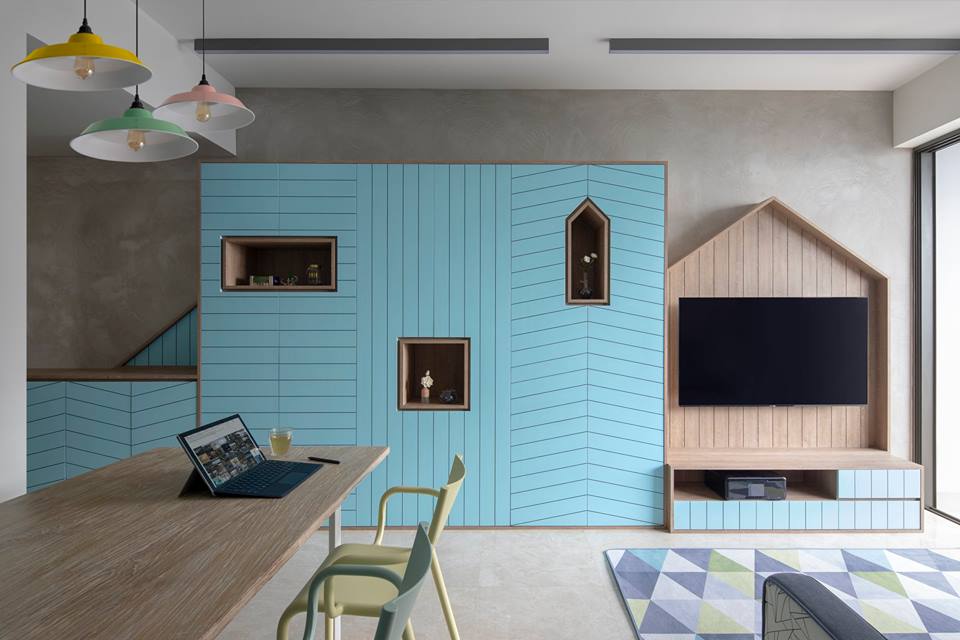Noisy home? Here's how to create a quieter one

Mahjong-playing neighbours? Live next to the MRT tracks or a busy expressway? Work from home and just need some peace and quiet from your own kids?
Noisy home dwellers, we hear you. From investing in noise-cancelling window treatments to building bookshelves, these tips should help you create a quieter home.
SOLUTIONS AGAINST NOISY NEXT-DOOR-NEIGHBOURS
A. BUILD CARPENTRY

B. ERECT A DRYWALL
If you don't need the extra storage, consider building a drywall packed with rockwool insulation against the dividing wall to block off the unwanted noise. Rockwool, a dense, fibrous material made from minerals, will reduce the air mass between the panels of drywall and therefore help to deflect sound transmission.
But if the noisy neighbours are coming from upstairs rather than next door, do up a false ceiling and have it similarly filled with rockwool.
C. MOVE YOUR FURNITURE
A third (and easier) option is to place a large piece of furniture such as your sofa, buffet table or a canvas painting against the shared wall. It might not cut off the noise from your next-door neighbours completely, but it will help to ease some of it.
SOLUTIONS AGAINST NOISE FROM THE OUTSIDE (MRT TRACKS, TRAFFIC, SCHOOL, NEXT TO THE PAVILION, ETC.)
A. GET BLACKOUT CURTAINS

When looking out for blackout drapes, get ones that are made from a dense and heavy material like velvet as they are more effective in blocking off noise compared to curtains made from a lighter material. Pleated ones will go further in helping to reduce noise.
Install your curtains over a sturdy rod and ensure that they are wider than your windows - this creates more pleats - and that they reach all the way to the floor to minimise any gaps through which noise can pass through.
B. REPLACE YOUR WINDOWS WITH SOUNDPROOF ONES
[[nid:467347]]
If you have the moolah to spare, consider investing in double-glazed windows, which are better at reducing sound transmission than standard windows. Double-glazed windows comprise of two layers of glass with a layer of air trapped between them, sort of acting like a vacuum in which sound cannot travel.
Note that if you're living in an HDB flat with full-height windows, you are not allowed to replace them unless in cases where there is a damaged frame. In this instance, you will have to request for an approval from HDB before replacing your windows.
C. LINE PLANTS ALONG YOUR WINDOWS

Plants can also help to reduce sound, so consider placing them by the windows as an extra barrier against outside noise. In general, the more plants the better.
Reduce the gaps between your greenery to serve as a more effective sound barrier. Use tall plants with large fleshy leaves rather than thin, needle-like leaves as the former are better at deflecting sound.
SOLUTIONS AGAINST NOISE FROM WITHIN YOUR HOME
A. SWAP OUT YOUR HOLLOW-CORE DOORS
An easy way to check if your door is hollow cored is to knock on it. If it sounds hollow, it most likely is hollow. Most hollow-core doors are also painted rather than stained. And if there are panelling on them, it is likely to be faux rather than real.
B. USE SOFT FURNISHINGS TO ABSORB NOISE

Soft furnishings are also known to absorb noise. Furnish the rooms e.g. kid's playroom, the family entertainment room, where you want to reduce noise levels with large area rugs. Cut pile rather than loop pile types are known to be better sound absorbers. Also, deck out the space with textiles, cushions and throws.
C. SOURCE FOR APPLIANCES THAT ARE QUIET
Many a times, the noise coming from within our homes are actually from the vibrations and buzzing produced by our devices and appliances. From things like your fan, washing machine, air purifier, refrigerator and vacuum cleaner.
While we cannot completely eliminate noise from these appliances, you can source for quieter ones when shopping for them. Look out for appliances that are designed to be quiet and check out their decibel levels to see how loud they will be when in used.
Especially for appliances that run over a longer period of time like an air purifier, you want to opt for one that has decibels around 40 dBA or less.
This article was first published in Renonation.